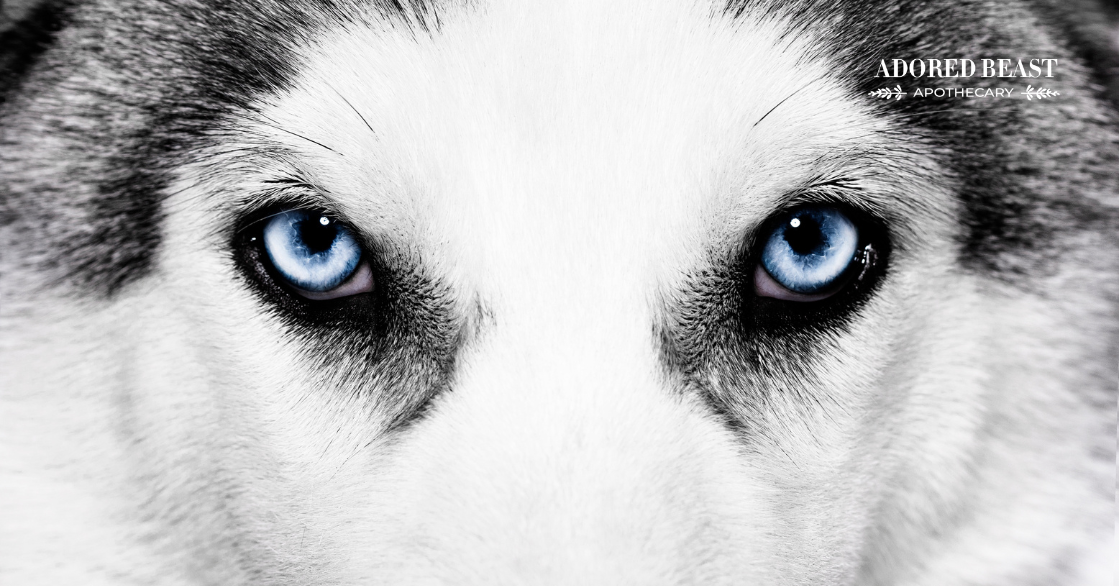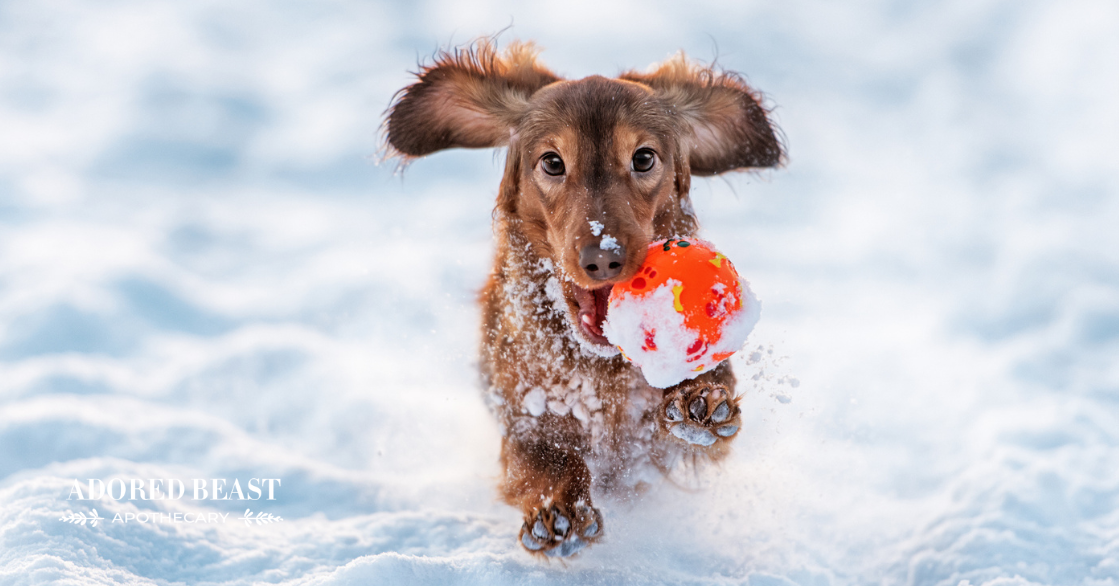They say the eyes are the window to the soul. When we gaze into our animals’ eyes, we connect with them on a level that goes beyond explanation. This bonded gaze releases oxytocin, a hormone that helps boost health for both of us. They are precious – so we, as pet parents, need to both protect them as much as we can, and recognize the signs if something is off.
When it comes to dog eye health, there are a number of things that can go wrong, either due to issues at birth, injuries or illness over the years, or just general degeneration as our dogs age. Knowing how to the spot the symptoms of an eye issue is important, and that’s what this blog is all about.
Your Dog’s Eyes
Your dog’s eyes are very similar to your own, with a few small differences. Like yours, they have an upper and lower eyelid, a cornea, an iris, a pupil, a retina, a lens, a sclera (the white of the eye), and a conjunctiva. Dogs also have two special structures that humans don’t:
- Tapetum lucidum: Located behind the retina, the tapetum lucidum reflects light through the retina, increasing the light available to the photoreceptors. This is why animals see better at night, and it makes an animal’s eyes appear to glow at night when lights reflect from the animal’s eye.
- Third eyelid: Known as the nictitating membrane, the third eyelid is whitish in color and is located at the corner of the eye, near the nose. It helps protect the eye from scratches and also moves across the eye when a dog blinks to help produce tears.
Despite having very similar eyes to us, the differences in structure mean that our dogs see differently. For example, our dogs can’t actually see objects as well as us, typical vision being about 20/75 (a dog has to be 20 feet away to see an object as well as a person can see at 75 feet away). They also have more rods in the retina, so they can see moving objects better than stationary ones. And, those additional rods, larger pupils, and a lens that is closer to the retina, mean they can see better in the dark that we can. The tapetum lucidum, which reflects light, also allows for better night vision.
So, their eyes are similar, and that means that they can develop many of the same eye issues that we do…
The Top 10 Most Common Dog Eye Health Problems
Dog eye health problems are much the same as ours, including cataracts, glaucoma, and other problems. As mentioned, some eye issues can also be present at birth, while others come after an injury.
These are the 10 most common, and what to watch for. Eye issues are often not serious, but they can be, or can become serious if left untreated. Every dog is different, and may exhibit different symptoms, but if you notice any of the signs, make an appointment with your veterinarian.
**The first signs of all eyes issues are often rubbing them on the furniture (the edges of the sofa, bed, or chairs) or pawing at the eyes. This can be from pain or itching.
1. Conjunctivitis
Conjunctivitis is an infection of the conjuctiva, the moist mucosal tissue around the eye and under the eyelid. It can be caused by bacteria, viruses, or fungus.
Signs to watch for:
- Yellow, green, or red discharge, or thick, white discharge
- Swelling, crusting, or hair loss on the eyelids
- Redness
- Squinting
- Rubbing or pawing at the eyes
2. Glaucoma
Glaucoma is increased pressure in the eye. When the eye is healthy, fluid flows in and out of the eye to maintain pressure. With glaucoma, there is either too much fluid going in, or there’s a drainage problem, which causes a greater amount of pressure. This can be caused by damage to the lens, inflammation of the interior of the eye, severe intraocular infections, anterior dislocation of the lens, tumors, and intraocular bleeding.
Signs to watch for:
- Changes in behaviour: depression, avoiding corners, don’t want area around the eyes being touched (early signs)
- Eye pain or redness
- Visible vessels on the whites of the eye
- Swelling or bulging of the eye
- Cloudy cornea
- Squinting
- Irritated by any air blowing on their face
3. Cataracts
Cataracts can be inherited or caused by other diseases such as diabetes, and can affect one or both eyes. They can also develop as a part of normal aging, or inflammation following an injury. Glucose being too high in the body can also trigger their development. Cataracts form when the proteins begin to clump together and form into a cloud-like substance in the eye’s lens. Cataracts can start small and grow large, or they can appear overnight.
Signs to watch for:
- Loss of vision
- Cloudiness in the centre of the eye
4. Corneal Ulcer
A corneal ulcer is a scratch or injury on the surface of a dog’s cornea, or the clear part of the eye. They can be caused by an injury or infection, or from inflammation of the cornea due to chronic dry eye. They can be very painful. Dogs with “buggy” eyes, like brachycephalic breeds, are especially prone to this.
Signs to watch for:
- Cloudiness in the front of the eye
- Green, yellow, or clear discharge
- Squinting the eye closed or rubbing at the eye
5. Cherry Eye
This is the prolapse of that third eyelid. The third eyelid has a special gland that produces a significant portion of the eye’s protective tear film. Cheery eye is when this gland prolapses or “pops out”. It is genetic, with certain breeds like more risk than others. Smaller breeds and breeds with shorter muzzles are at a greater risk of suffering from the cherry eye.
Signs to watch for:
– Red swollen mass on the lower eyelid near the nose
6. Dry Eye (Keratoconjunctivitis sicca [KCS])
Dry eye is when a dog’s tear glands don’t produce enough tears. This can lead to more severe complications, like corneal ulcers, pain, and chronic mucus drainage from the dog’s eyes. It is usually caused by autoimmune disorders, but it can also be caused by a middle ear infection, trauma, damage to the facial nerve, viral or bacterial eye infections.
Signs to watch for:
- Red eyes
- Pain
- Squinting
- Discharge
7. Allergies
Just like humans, allergies can really irritate the eyes. Whether they’re environmental or food related, allergies can cause the eyes no end of trouble.
Signs to watch for:
- Red, itchy eyes
- Green, yellow, or clear discharge from the eyes (bacterial infections are common)
8. Retinal Detachment
Retinal detachment refers to the separation of the retina from the back of the eyeball. If it happens in both eyes it is most often caused by an underlying medical condition such as glaucoma, high blood pressure and/or hypothyroidism. Exposure to toxins may also result in the detachment of the retina. It can happen to any dog at any age, but is more common in seniors or dogs born with congenital health defects.
Signs to watch for:
- Redness
- Vision loss
- Discharge
- Swelling
- Dilated pupils that do not adjust properly to light
9. Trauma
Trauma, as from an injury, is another dog eye health issue to be aware of. Eye injuries include foreign bodies, scratches, perforating injuries, chemical, or contact corneal trauma. Getting hit with a ball, a frisbee, a stick or really anything you’re throwing to them, are the most common causes of trauma to the eye. Injuries to the eye can lead to permanent scarring or blindness if penetrating or ulcerative lesions develop.
Signs to watch for:
- Pain
- Squinting
- Eyelid not functioning properly
- Rapid blinking
- Bloody or bloodshot eyes
- Pawing at the eye
- Discharge
- Cloudiness
- Distorted pupil
10. Retinal Degeneration
This is a hereditary condition where the retina is affected by degeneration of the tissue. The precise causes are unknown. However, most agree that aging and genetics are factors. Excessive exposure to sunlight, hypertension or high blood pressure, obesity, and certain prescription medications are other factors.
Signs to watch for:
- Impaired vision – difficulty distinguishing details and colours, judging distances, edges or stairs
- Bumping into objects
- Light sensitivity
Protecting Those Peepers
Proactive dog eye health care is important, and thankfully there are things we can do as pet parents to protect those peepers.
Dog Eye Health Protection Tips:
- Know your breed. Certain breeds are predisposed to conditions of the eye. For example, bulldogs and mastiffs are prone to entropion – a condition where the eyelids roll inward and rub painfully against the cornea. Be sure to research any conditions or diseases that your dog may be predisposed to so you know exactly what to watch for! If you know your dog is higher risk, make sure you’re feeding to protect eye health (see below).
- Don’t let your pup stick their head out the car window. Dogs that ride with their heads out the car window are exposed to ocular dryness and debris caused by heavy winds. Plus, it can be dangerous for a variety of other reasons.
- Keep your dog’s eyes clean. Dogs’ eyes produce watery and mucousy discharge that can be perfectly normal. But unlike us, their eyes are surrounded by hair that can trap this discharge – not to mention dirt and environmental debris! For most short haired dogs, some cotton gauze or a cotton face cloth and a bit of eye flush is all you need to keep peepers clean. (Never use cotton balls or tissues – they have fine fibres that are nightmares for anything: eyes, nose, cuts, wounds.) However, longer haired dogs and those with chronic eye conditions should be groomed regularly to prevent matting and excess build-up. Remember to be gentle.
- Watch for sharp objects, especially where you’re playing.
Food and Supplements for Eye Health
There are several foods that help protect the eyes:
- Blueberries – Contain two very important eye healthy carotenoids – lutein and zeaxanthin, plus nutrients that support night vision, prevent macular degeneration and even reduce eye fatigue!
- Eggs – Egg yolks contain lutein which reduces risk of developing macular degeneration.
- Kale – An excellent source of lutein, zeaxanthin and betacarotene.
- Broccoli – A great source of lutein and zeaxanthin, that’s also packed with beta-carotene.
- Carrots – Contain pro-vitamin A, betacarotene, vitamins B, C, D, E and K, riboflavin, niacin, calcium, potassium, phosphorus, sodium, iron, magnesium, manganese, sulphur, copper, iodine, lycopene and lutein!
- Pumpkin – Packed with carotenoids such as beta-carotene, which help neutralize free radicals.
- Organs (specifically eyeballs) – Organs support organs, and are packed with vitamins and minerals that help support eye health.
Supplements can also be beneficial:
- Omega 3s – EPA and DHA, two Omega-3s important to cellular healthy, and therefore dog eye health.
- Antioxidants – Antioxidants are proving to be incredibly useful for protecting eye health, especially for conditions such as degeneration and cataracts. They fight free radicals and protect the cells from the effects of oxidative stress.
- Pre and Probiotics – Gut health may not come to mind when you think about eyes, but gut health is foundational to overall health. It is paramount to managing chronic inflammation in the body which is at the root of so many different conditions which threaten eye health.












